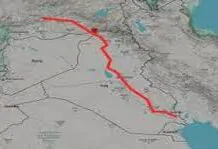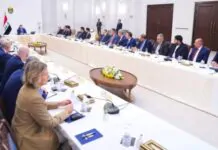Good Morning ,
FINANCE — IMF Warns of Systemic Strain: Early Signals of a Monetary Realignment
Mounting debt, overvalued assets, and policy fatigue point to the quiet re-engineering of global finance.
The International Monetary Fund’s October 2025 Global Financial Stability Report has quietly set off alarm bells across policy circles. Beneath its restrained tone, the IMF outlines a world financial system that is structurally fragile and increasingly dependent on non-bank financing—just as sovereign debt and liquidity pressures mount worldwide.
Key Points
- Systemic risk is rising: stretched asset valuations and tightening global liquidity are leaving major economies vulnerable.
- Sovereign-bond stress is building as refinancing costs grow, particularly in emerging markets.
- Non-bank financial institutions (NBFIs) now handle a growing share of global credit flows, often outside regulatory reach.
- Foreign-exchange markets are showing higher volatility as nations hedge against policy divergence and geopolitical uncertainty.
These trends, taken together, suggest that the financial architecture built after 2008 is nearing the limits of its stability.
Why It Matters
The IMF’s findings align with broader signals of what analysts are calling “Bretton Woods 2.0” — a structural monetary reset.
As public debt soars and confidence in fiat systems erodes, central banks are reassessing the very foundation of liquidity, collateral, and cross-border settlement.
- Expect new reserve frameworks emphasizing diversification and digital infrastructure.
- Monetary policy coordination may shift toward regional blocks rather than global consensus.
- The U.S. dollar’s privileged role is under silent review, even among allies.
The world’s financial plumbing is being redesigned — not in crisis mode, but through gradual realignment.
This is not just politics — it’s global finance restructuring before our eyes.
Seeds of Wisdom Team
Newshounds News™ Exclusive
Sources
- IMF Global Financial Stability Report, October 2025 — imf.org
- “Bretton Woods 2025: The Coming Monetary System Reset” — discoveryalert.com.au
~~~~~~~~~
DIPLOMACY & PEACE — The Quiet Currency War: BRICS, Washington, and the Struggle for Financial Influence
As alliances shift, currency diplomacy becomes the new battlefield of global power.
In the halls of Beijing, Moscow, and Washington, a subtle but defining struggle is underway — not for territory, but for monetary alignment.
This week’s diplomatic signals reveal that the United States is pressuring several nations to re-anchor trade and settlements back to the U.S. dollar, countering the BRICS bloc’s de-dollarization strategy.
Behind these negotiations lies a profound transformation: financial diplomacy has replaced traditional military leverage.
Key Developments
- Washington’s renewed dollar diplomacy now targets eight emerging economies to sustain dollar liquidity and influence.
- China and Russia, through the BRICS New Development Bank, are promoting local currency settlements and cross-border systems outside SWIFT.
- Bilateral trade pacts increasingly bypass the dollar, from energy to tech supply chains.
- Geoeconomic competition is now the main channel through which global influence is exercised.
Why It Matters
This is not a passing currency debate — it is a foundational shift in how power is expressed.
Financial institutions, trade routes, and reserve choices are now direct tools of diplomacy.
- A multipolar reserve currency network could weaken traditional sanctions and reshape global credit markets.
- Countries aligning with BRICS structures may gain autonomy from U.S.-centric systems, but face transition risk and liquidity gaps.
- If de-dollarization accelerates, global governance frameworks (IMF, BIS, SWIFT) will need to adapt to multi-standard interoperability.
The old world of “finance serving diplomacy” is gone. In its place, diplomacy now serves finance — and the contest for global monetary leadership has begun.
This is not just politics — it’s global finance restructuring before our eyes.
Seeds of Wisdom Team
Newshounds News™ Exclusive
Sources
- BRICS Bank Fuels Russia’s De-Dollarization Push — Global Finance Faces Reset — news.bitcoin.com
- Investors Brace for Trump–Xi Trade Talks Amid Familiar Optimism and Caution — m.economictimes.com
~~~~~~~~~
MARKETS — Fear and Flow: Why Investors Are Fleeing to Safety as Regimes Shift
Volatility and uncertainty are redefining the risk map of global markets.
From Wall Street to Singapore, investors are quietly repositioning. Safe-haven assets are rising, volatility is back, and liquidity flows are moving from growth to defense.
The trigger? A convergence of monetary stress, political uncertainty, and systemic fatigue — the key ingredients of regime transition.
As the U.S. dollar climbs to a two-month high, and gold continues to outperform expectations, the markets are sending a clear message: the post-2008 playbook no longer fits.
Key Developments
- Dollar strength reflects defensive positioning, not confidence — investors are hedging against policy indecision and fiscal instability.
- Gold demand has surged as portfolios rebalance toward real assets amid declining trust in paper markets.
- Bond markets show unusual divergence: yields signal recession risk even as equities remain inflated by policy inertia.
- Emerging markets face renewed capital outflows as investors seek shelter in liquidity-rich assets.
Why It Matters
These patterns are symptomatic of a deeper market recalibration.
Behind short-term volatility lies a reordering of how capital perceives safety, growth, and value.
- Traditional correlations are breaking down — equities and bonds no longer move inversely, weakening classic risk hedges.
- Monetary divergence between the U.S., Europe, and Asia is fragmenting global liquidity, reshaping capital flows.
- Fear-based allocation is replacing fundamentals as the dominant trading logic — a signal that investors anticipate systemic transition.
In essence, markets are pricing in the end of an era — not a crisis event, but a shift in the global financial operating system.
Sources
- Dollar Climbs to Two-Month High as U.S. Shutdown Deepens and Global Uncertainty Grows — moderndiplomacy.eu
- What Happens When the Gold Bubble Finally Bursts? — moderndiplomacy.eu
~~~~~~~~~
METALS — Gold’s Return to Power: What Central Banks Are Really Signaling
Behind the rally in gold lies a quiet reconfiguration of global trust and reserve policy.
For decades, gold was dismissed as an anachronism — a relic of the pre-digital era. Yet in 2025, it’s back at the center of global finance.
Central banks from Beijing to Riyadh have been accumulating gold at record pace, signaling a strategic diversification away from traditional reserve currencies.
The rise in gold is not merely speculative — it’s structural. It reflects a deep reassessment of what “money” and “trust” mean in a system stretched by debt, currency politics, and digital transition.
Key Developments
- Central banks are net buyers for the third consecutive year, expanding gold’s role in sovereign balance sheets.
- Emerging markets are leading accumulation as insurance against sanctions, FX volatility, and dollar exposure.
- Analysts warn that the current gold rally is driven less by inflation fears and more by monetary realignment.
- Private investors mirror the trend: ETFs and vault holdings have risen steadily since mid-2024.
Why It Matters
Gold’s resurgence marks the return of tangible credibility in a digitalizing system.
As trust in fiat and debt-based assets erodes, nations are hedging against a future where financial power may fragment across multiple standards.
- Expect gold to re-emerge as a partial collateral anchor in cross-border payment systems.
- A hybrid reserve model — combining metals, digital tokens, and diversified currencies — is becoming plausible.
- For investors, this signals a structural portfolio rethink: gold is not a trade; it’s a geopolitical hedge.
The move by central banks to hard assets is not nostalgia — it’s a calculated preparation for a post-fiat monetary environment.
This is not just politics — it’s global finance restructuring before our eyes.
Seeds of Wisdom Team
Newshounds News™ Exclusive
Sources
- What Happens When the Gold Bubble Finally Bursts? — moderndiplomacy.eu
- Global Monetary Reset Signs and Implications, 2025 — discoveryalert.com.au
~~~~~~~~~
Seeds of Wisdom Team RV Currency Facts Youtube and Rumble
Newshound’s News Telegram Room Link
Follow the Gold/Silver Rate COMEX
Follow Fast Facts
Seeds of Wisdom Team™ Website






